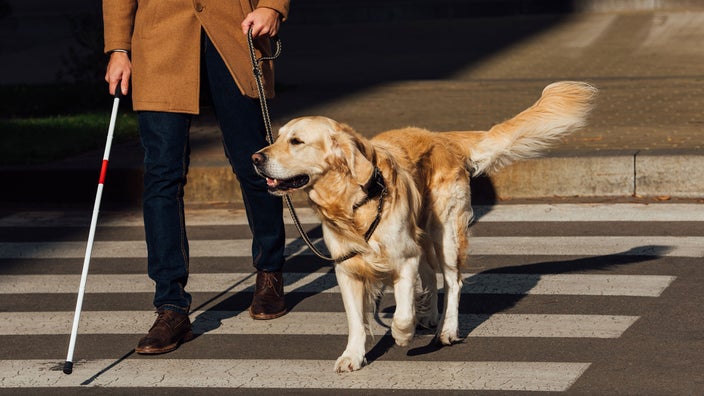
How Much Does a Service Dog Cost?
Key takeaways:
A trained service dog can cost from $15,000 to $30,000 or more upfront, in addition to at least $500 a year for food and veterinary care.
Most commercial and government health insurance — including Medicare, Medicaid, and the Department of Veterans Affairs (VA) healthcare program — won’t cover the cost of acquiring a service dog.
There are several nonprofit groups that raise money to help people acquire a service dog at little or no cost. However, many of these organizations have yearslong waiting lists.

Having a disability can be challenging, but a service dog can improve your quality of life by helping you perform tasks.
Acquiring a trained service dog can cost tens of thousands of dollars. And the expenses don’t stop there. In addition to upfront costs, caring for a service dog requires paying for food, toys, healthcare, and additional training.
What is a service dog?
Service dogs are working animals — not pets. They’re also different from dogs and other animals that provide therapy, emotional support, or otherwise aid humans.
The Americans with Disabilities Act (ADA) defines a service animal as a dog who is trained to do work or perform tasks for people with disabilities. (There is a separate ADA provision for miniature horses who are trained to aid people with disabilities.)
Examples of tasks a service dog may perform include:
Guiding a person who is blind
Alerting someone who is deaf
Pulling a wheelchair
Protecting a person who is having a seizure
Reminding a person to take prescribed medication for a mental health condition
Calming a person who has post-traumatic stress disorder (PTSD) during an anxiety attack
Read more like this
Explore these related articles, suggested for readers like you.
An animal wearing a vest or ID that says they are a service animal is not necessarily one. Animals whose sole purpose is to provide comfort, companionship, or emotional support do not qualify as service animals under the ADA.
Dogs and other animals not eligible for ADA classification as a service animal include:
Working dogs: These canines perform jobs. Dogs in police K-9 units are perhaps the most visible and well-known working dogs. Within and outside of law enforcement, working dogs serve in a variety of roles, such as search and rescue, explosive detection, cancer detection, and allergen detection.
Therapy dogs: These animals help without attachment to a specific handler. They often volunteer along with a human teammate in hospitals, nursing homes, and schools, where they provide people with affection and joy. Often, these dogs are furry celebrities.
Emotional support animals: Along with dogs, this category includes many types of animals. These companions may be trained for a specific owner, but don’t perform tasks associated with a disability. A healthcare professional may prescribe an emotional support animal for someone diagnosed with a mental health condition. Their comforting presence helps ease anxiety, depression, loneliness, and some phobias.
Who qualifies for a service dog?
Under the ADA, service dogs (and sometimes miniature horses) do work or perform tasks for people with disabilities. These animals can be trained to help people with the following disabilities:
Blindness (partial and complete)
Deafness (partial and complete)
Paralysis
Mental health conditions, including PTSD, in the case of psychiatric service dogs
The ADA doesn’t specifically name all of the conditions covered under the law. To be protected by the ADA, a person must have a physical or mental impairment that substantially limits at least one major life activity, have a history or record of a disability, or be perceived by others as having a disability.
What is the average cost to acquire a service dog?
The National Service Animal Registry estimates the upfront cost of a service dog to be $15,000 to $30,000. But they can cost as much as $50,000. This price tag may include breeding, raising, training, and placing the dog.
You may be able to reduce your costs by training your dog to perform needed tasks yourself, which is allowed under the ADA.
What is the average cost to maintain a service dog?
In addition to initial expenses, a service dog can cost anywhere from $500 to $10,000 a year for upkeep, which includes food and veterinary care.
Will insurance cover a service dog?
Health insurance plans for people typically do not extend coverage to animals — even service animals. If you need medical coverage for your service dog, consider buying pet health insurance.
One exception is a special program for veterans with service dogs who are trained by organizations accredited by Assistance Dogs International (ADI) or the International Guide Dog Federation (IGDF). The Department of Veterans Affairs (VA) offers a service dog veterinary health insurance benefit for eligible veterans who need guide, hearing, seizure, and mobility dogs. The VA does not cover the cost of acquiring service dogs but will provide them with pet insurance.
Does Medicare cover a service dog?
Medicare does not cover the cost of acquiring or maintaining a service dog.
What should you do if you can’t afford a service dog?
Most of the cost of a professionally trained dog is associated with the investment in their training. You can train your service dog yourself, which is allowed under the ADA — and can save you money.
There also are nonprofit organizations that pair people with trained service dogs and don’t charge for the animals. However, many of these groups have extensive applications with specific requirements and long waiting lists.
These organizations, all of which are accredited by ADI, include:
Freedom Service Dogs of America: There is no fee for the service dogs provided through this organization, but there is a wait of at least 3 years once your application is accepted. You must be financially stable enough to provide for the dog’s needs. And you must travel to the Denver area to meet a dog, determine compatibility, and participate in a 2-week placement class at the group’s training facility.
Paws With A Cause: An application request for this organization costs $25. The application process is open certain times of the year and applicants must live in specific areas of the U.S. The value of breeding, raising, training, and placing a dog from this organization exceeds $35,000.
NEADS World Class Service Dogs: This organization requires you to fill out a pre-qualifying questionnaire before submitting an application. If your application is chosen, you must accept a set fundraising commitment, which was $8,000 in late 2022. (There is no fundraising required for eligible veterans.)
The bottom line
Service animals are defined by the American with Disabilities Act (ADA) as dogs — and sometimes miniature horses — that are specifically trained to perform tasks and do work to help people with disabilities. There is no specific training, certification, or registration required by the federal law.
A trained service dog can cost as much as $15,000 to $30,000 — and even up to $50,000 — upfront. But you can save money on upfront costs by training your own dog. Upkeep and healthcare can cost $500 or more each year.
It’s highly unlikely that your health insurance will cover the cost of acquiring a dog, but eligible veterans can access the Department of Veterans Affairs (VA) service dog veterinary health insurance benefit for medically approved service dogs. Many nonprofit organizations pair trained service dogs with people who have disabilities at little or no cost, but the wait times for these animals can be years.
Why trust our experts?


ADA.gov. (2015). Frequently asked questions about service animals and the ADA.
ADA.gov. (2020). ADA requirements: Service animals.
Freedom Service Dogs of America. (n.d.). About Freedom Service Dogs.
Freedom Service Dogs of America. (n.d.). FAQs: FSD service dogs.
National Service Animal Registry. (2022). How much does a service dog cost: A buyer’s guide for your service dog.
NEADS. (n.d.). NEADS world class service dogs change lives.
Paws With A Cause. (n.d.). Application requests.
Paws With A Cause. (n.d.). Field rep coverage area.
Paws With A Cause. (n.d.). Our mission.
Reisen, J. (2021). Service dogs, working dogs, therapy dogs, emotional support dogs: What’s the difference?. American Kennel Club.
U.S. Department of Veterans Affairs. (n.d.). Rehabilitation and prosthetic services.
U.S. Department of Veterans Affairs. (2020). Service dog veterinary health insurance benefit (VHIB) rules.



























